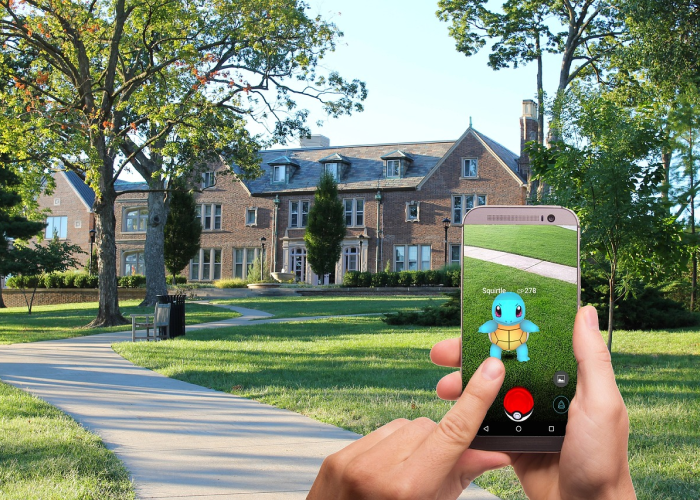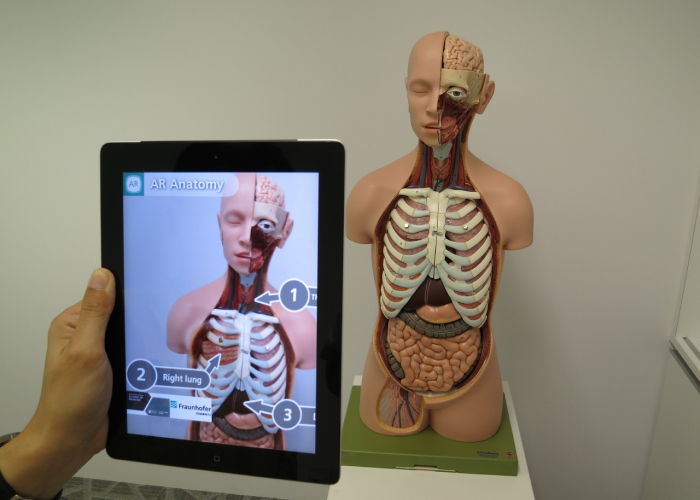How Does Location-Based Augmented Reality Work?
Benefits of Using Location-Based AR
Applications of Location-Based AR for Different Industries
Are you familiar with the term “location-based Augmented Reality”? Even if the phrase is new to you, I’m sure that you have already come across applications that use this modern technology. One of them is Pokémon GO, a popular game released in 2016 that became a global phenomenon, reaching immense popularity in just a few days.
What was the secret to its success? Pokémon GO used real-world maps and GPS data to place virtual creatures in the player’s surroundings, encouraging users to explore their environment to find and capture Pokémon.
Though the game’s widespread popularity demonstrated the potential of location-based AR, many business owners are still unfamiliar with this technology. Given that HQSoftware has developed numerous AR solutions, I decided to create a comprehensive guide explaining what location-based AR is, how it works, and how it is utilized across various industries today.
How Does Location-Based Augmented Reality Work?
Benefits of Using Location-Based AR
Applications of Location-Based AR for Different Industries

Location-based AR, also referred to as position-based or geo-based Augmented Reality, overlays digital content onto the physical world based on the user’s location. It achieves this by utilizing GPS, Wi-Fi, cellular data, or other tracking technologies to determine the user’s precise position and orientation.
Location-based AR is also called “markerless” because it doesn’t require any physical markers to trigger the Augmented Reality experience. To make it easier to understand the difference, let’s compare marker-based AR and markerless AR:
You probably already have questions: how does Augmented Reality work and how does it get location information? The mechanism for such an application depends on real-time location systems (RTLS). Here it is important to consider three key aspects:
Sensors: AR technology obtains information about the user’s location and movements using various sensors. These are the most important elements of geolocation applications, as the system’s accuracy depends on them. For the application to run smoothly, the sensors must be properly placed and configured, and transmit accurate data.
Points of interest: POIs can be described as virtual objects or layers of the image displayed on the user’s screen. Once the system receives the user’s location data, it identifies the nearest points of interest and displays them in Augmented Reality.
Data synchronization: Accurate user location data and proper synchronization of data coming from sensors and POIs is important for a markerless application to work. The more accurate this data is, the more realistic and better the Augmented Reality display will be.
Considering custom software?HQSoftware’s team of experts can design and develop the perfect solution for your business. Let’s discuss it
Dmitry Tihonovich
Business Development Manager
One of the main benefits of location-based AR is its ability to create a unique user experience where content is made available at the right time and place. This makes interaction with the application more engaging and immersive. Users access information related to their surroundings and can interact with virtual objects for everyday tasks or work purposes.
For example, a travel app can show interesting historical facts about a landmark when a person passes by it, or a shop can send personalized offers or information about discounts when a customer is nearby.
The second advantage of location-based AR is its potential to improve the educational process. Using Augmented Reality in educational institutions makes it possible to create interactive lessons and training programs that provide more effective interaction with the educational material.
For example, architecture students can visualize their projects in real space. Medical students studying human anatomy can use location-based AR to explore 3D models of the human body directly in their classroom or lab. Even science experiments and visualizations of mathematical formulas become available thanks to Augmented Reality.

Location-based Augmented Reality makes it possible to create a truly interactive experience. Users can not only receive information but also actively interact with virtual objects in the real world. For example, when buying furniture, customers can use the app to arrange virtual models of sofas, tables and chairs right in their home. They can change color or size, and virtually move items around the space to see how they fit into the room. This not only helps customers make the right purchase decision, it makes selecting furniture more fun and convenient.
Location-based AR makes navigation much easier and clearer. Instead of looking at a traditional map, users see directions right in front of them in the real world. Arrows show where to go, where to turn, and virtual markers mark important locations. This is especially useful in complex spaces that are quite difficult to navigate, such as large shopping malls, airports, or unfamiliar cities. Navigation becomes intuitive and does not require constant shifting of attention between the map and reality.
It should be noted that despite all of its advantages, location-based Augmented Reality is still in the development stage and needs further research and improvement. One of the big challenges is the limited availability of devices capable of supporting it, as well as the limited accuracy of position and orientation detection in space.
How do modern businesses use AR to increase their revenues and outperform their industry competitors?

Location-based Augmented Reality is changing how various industries operate by improving user experiences and providing real-time information. From making travel more exciting to enhancing shopping experiences, AR is creating engaging and immersive experiences. In this section, I’ll look at how various sectors use location-based AR to improve their services.
Location-based Augmented Reality is a great way to enhance the travel experience. Therefore, it is widely used in the tourism industry. It helps tourists discover new places and quickly find the most popular attractions in real time using mobile devices. When a user points their device at a landmark or area, the AR app overlays relevant information, such as historical facts, navigation tips, or nearby points of interest, directly onto their view. This allows travelers to explore surroundings in a more immersive way.

Augmented Reality is dramatically improving the way we visualize, plan and design urban environments. A life-size 3D design of a building is placed visually exactly where it is expected to be built. It can be walked around, approached to examine the details, inspected by going inside. At any stage of construction, it is convenient to check the project in Augmented Reality, which is an undoubted advantage.
In the gaming industry, location-based AR creates immersive real-world adventures. Players can participate in city quests where virtual clues appear at specific locations. Investigation games, where you have to search for clues throughout the city, or adventure games with virtual treasures are also very popular. For example, players can collect virtual artifacts at historical locations and then use them to solve mysteries.
Need a custom software solution? We’re ready to help!HQSoftware has a team of skilled professionals ready to tackle the project. Ask me!
Natallia Rudzik
Business Development Manager
In education, AR makes it possible to create interactive lessons right on the ground. In biology lessons, students can see 3D models of the internal structure of plants by pointing the camera at real objects. In astronomy lessons, the app shows the location of constellations in the real sky. In geography lessons, students can study geological processes through visualizations of the landscape.
Stores are using location-based AR to improve the shopping experience. When entering a mall, an app can build an optimal route to the desired retail store. Shoppers can see personalized discounts on items they pass by. When you hover over a product, detailed information and reviews appear. In grocery stores, you can see the product ingredients, calorie content and cooking recommendations.
AR improves the process of finding and selling real estate. Walking down the street, the user can see information about apartments for sale or rent in the building, and their layout and price. When visiting an empty apartment, the app allows users to virtually arrange furniture in real scale, choose different decor options or see the view from the window at different times of the day. According to real estate agents, they have much less trouble advertising their offerings when they trust location-based AR.

Location-based Augmented Reality helps marketers create unique advertising campaigns. Billboards “come to life” when the camera is pointed at them, showing interactive content. Virtual promoters appear in shopping centers, telling potential customers about ongoing promotions.
Some brands create AR-quests where participants collect virtual items in real store locations. At events, guests can see additional information about products or participate in interactive presentations. All these help marketers achieve their main goal of capturing audience attention in a memorable way and creating engaging experiences that drive brand interaction.
In healthcare, location-based AR helps both patients and doctors. For example, some hospitals use AR-based navigation apps to guide patients and visitors through complex facilities. These apps display turn-by-turn directions overlaid on the device’s screen, helping people find departments, clinics, or specific rooms efficiently.
HQSoftware is a company that uses modern technology to bring our customers’ ideas to life. And from our experience, I can say that location-based Augmented Reality is an effective tool that helps companies create a more immersive and interactive user experience. This approach engages audiences, builds customer loyalty and helps increase sales.
As an example, let’s take a look at the AR app for real estate marketing that the HQSoftware team developed for our client from Norway. The app utilizes GPS navigation and geo-based methods to allow users to place and view 3D models of buildings on specific sites, making it possible to see a realistic visualization of future infrastructure on undeveloped land.
By leveraging the user’s geographic location, the app aligns virtual buildings with their actual building site, allowing users to examine them from different distances and perspectives (such as from afar, close up, or even from nearby waters). This location-based feature is essential for the app’s functionality, as it helps investors visualize developments in real-world contexts.
The app has been highly effective, resulting in a 42% increase in building investments. This impressive growth is attributed to the app’s ability to provide a clear, interactive preview of construction plans, making projects more attractive to potential investors.
Magical Park is an AR location-based app that transforms ordinary parks into magical spaces. The game was designed to encourage children to get active by combining digital play experiences with outdoor activities. Powered by GPS, it superimposes fantastic 3D models directly onto the physical environment, allowing children to interact with virtual objects such as dinosaurs, fairies and other fantastical characters that appear to be part of the real world.
In the app, children can participate in a variety of activities: rescuing fictional animals, collecting magical objects or avoiding virtual obstacles, which helps develop coordination and physical endurance. An important feature of Magical Park is its safety: the app can only be activated in specially authorized parks, where open spaces are provided and there are no potential dangers such as roads.
Florence Travel Guide is a location-based AR app that allows users to explore Florence independently. It utilizes the user’s geographic location to provide relevant information and interactive points of interest within the city.
By overlaying digital content onto the real world based on the user’s location, the app enhances the travel experience by helping users discover nearby points of interest such as restaurants, hotels, public bus stops, and museums. The offline mode even allows users to access this information without needing a constant internet connection, which is especially useful for travelers.
Star Walk is another example of a location-based Augmented Reality app. It utilizes the user’s GPS location and device orientation to provide an accurate overlay of celestial objects in the sky. When a user points their device toward the sky, Star Walk shows real-time information on stars, planets, constellations, and more, aligning virtual content with the actual sky based on the user’s position. This combination of AR with location-based data allows users to explore astronomy interactively from any location.
As a software development company offering Augmented Reality development services, HQSoftware understands the essential steps and tools required to build a successful location-based AR app. Let’s briefly outline these key elements:
To start building a location-based AR app, first set up the development environment for your target platform. For Android it is Android Studio; for iOS, Xcode. These environments provide the tools for coding, testing, and debugging.
Then you need to choose special tools for working with Augmented Reality — ARCore or ARKit.
The next important step is to set up geolocation so the app can accurately determine the user’s location. You’ll need to obtain permission to use geolocation on the device and write code for continuous location tracking. This tracking enables the app to adjust content based on the user’s movements, creating a dynamic experience. Additionally, make sure to optimize for battery efficiency, as constant tracking can quickly drain the device’s power.
The most challenging part is integrating Augmented Reality. You’ll need to configure the device’s camera to display AR objects in real-world locations. It’s essential to accurately calculate the size and position of these objects to ensure they appear naturally within the environment.
If you need consultation or are considering developing a location-based AR solution, our skilled team will support you throughout the entire process, ensuring your AR apps are engaging and effective. Whether you want to enhance user experiences or create immersive content, we’re here to help.
Contact us today to discover how we can elevate your projects with innovative AR solutions.

HQSoftware Founder
Having founded the company in 2001, uses his broad knowledge to drive the company forward. Ready to share his wisdom on software development and technology insights
We are open to seeing your business needs and determining the best solution. Complete this form, and receive a free personalized proposal from your dedicated manager.

Sergei Vardomatski
Founder